Fractions are the important topics in maths. This will be helpful in the real-time environment. Know-how and where to apply the formulas from this page. Get a detailed explanation for all the questions here. Download Eureka Math Answers Grade 4 chapter 9 pdf for free of cost. As per your convenience, we have provided the solutions in pdf format so that you can prepare offline.
Engage NY Eureka Math 4th Grade Module 5 Lesson 9 Answer Key
Get the guided notes for chapter 9 Answer Key from here. This will be the best resource to enhance your math skills. The topics covered in this chapter are Fractional units. test yourself by solving questions given at the end of the chapter.
Eureka Math Grade 4 Module 5 Lesson 9 Problem Set Answer Key
Each rectangle represents 1.
Question 1.
Compose the shaded fractions into larger fractional units. Express the equivalent fractions in a number sentence using division. The first one has been done for you.
a. 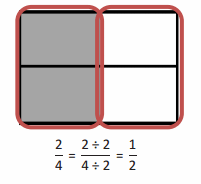
Answer:
2/4 = 1/2.
Explanation:
In the above-given question,
given that,
compose the shaded fractions into larger fractional units.
Express the equivalent fractions in a number sentence using division.
2/2 = 1.
4/2 = 2.
2/4 = 1/2.
b. 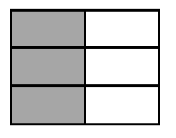
Answer:
3/6 = 1/2.
Explanation:
In the above-given question,
given that,
compose the shaded fractions into larger fractional units.
Express the equivalent fractions in a number sentence using division.
3/3 = 1.
6/3 = 2.
3/6 = 1/2.
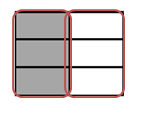
c. 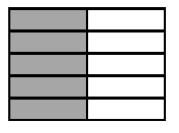
Answer:
5/10 = 1/2.
Explanation:
In the above-given question,
given that,
compose the shaded fractions into larger fractional units.
Express the equivalent fractions in a number sentence using division.
5/5 = 1.
10/5 = 2.
5/10 = 1/2.
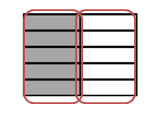
d. 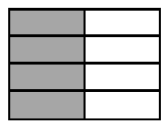
Answer:
4/8 = 1/2.
Explanation:
In the above-given question,
given that,
compose the shaded fractions into larger fractional units.
Express the equivalent fractions in a number sentence using division.
4/4 = 1.
8/4 = 2.
4/8 = 1/2.
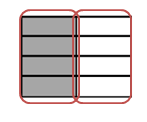
Question 2.
Compose the shaded fractions into larger fractional units. Express the equivalent fractions in a number sentence using division.
a. 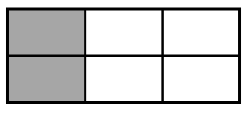
Answer:
2/6 = 1/3.
Explanation:
In the above-given question,
given that,
compose the shaded fractions into larger fractional units.
Express the equivalent fractions in a number sentence using division.
2/2 = 1.
6/2 = 3.
2/6 = 1/3.
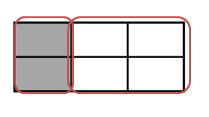
b. 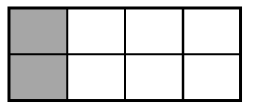
Answer:
2/8 = 1/4.
Explanation:
In the above-given question,
given that,
compose the shaded fractions into larger fractional units.
Express the equivalent fractions in a number sentence using division.
2/2 = 1.
8/2 = 4.
2/8 = 1/4.
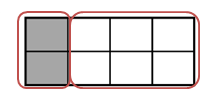
c. 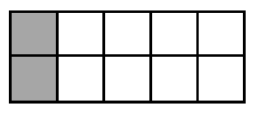
Answer:
2/10 = 1/5.
Explanation:
In the above-given question,
given that,
compose the shaded fractions into larger fractional units.
Express the equivalent fractions in a number sentence using division.
2/2 = 1.
10/2 = 5.
2/10 = 1/5.
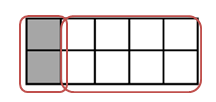
d. 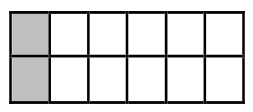
Answer:
2/12 = 1/6.
Explanation:
In the above-given question,
given that,
compose the shaded fractions into larger fractional units.
Express the equivalent fractions in a number sentence using division.
2/2 = 1.
12/2 = 6.
2/12 = 1/6.
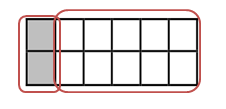
e. What happened to the size of the fractional units when you composed the fraction?
Answer:
The size of the fractional units is increased.
Explanation:
In the above-given question,
given that,
whenever the size of the fractional units decreases when we decompose the fraction.
decomposing = dividing.
whenever the size of the fractional units increases when we compose the fraction.
composing = adding.
f. What happened to the total number of units in the whole when you composed the fraction?
Answer:
The total number of units in the whole is increased when we composed the fraction.
Explanation:
In the above-given question,
given that,
the total number of units in the whole is increased when we composed the fraction.
Question 3.
a. In the first area model, show 2 sixths. In the second area model, show 3 ninths. Show how both fractions can be renamed as the same unit fraction.

Answer:
2/6 = 1/3.
Explanation:
In the above-given question,
given that,
compose the shaded fractions into larger fractional units.
Express the equivalent fractions in a number sentence using division.
2/2 = 1.
6/2 = 3.
2/6 = 1/3.
Answer:
3/9 = 1/3.
Explanation:
In the above-given question,
given that,
compose the shaded fractions into larger fractional units.
Express the equivalent fractions in a number sentence using division.
3/3 = 1.
9/3 = 3.
3/9 = 1/3.
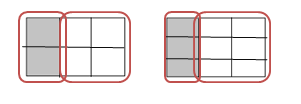
b. Express the equivalent fractions in a number sentence using division.
Question 4.
a. In the first area model, show 2 eighths. In the second area model, show 3 twelfths. Show how both fractions can be composed, or renamed, as the same unit fraction.

b. Express the equivalent fractions in a number sentence using division.
Answer:
2/8 = 1/4.
Explanation:
In the above-given question,
given that,
compose the shaded fractions into larger fractional units.
Express the equivalent fractions in a number sentence using division.
2/2 = 1.
8/2 = 4.
2/8 = 1/4.
Answer:
3/12 = 1/4.
Explanation:
In the above-given question,
given that,
compose the shaded fractions into larger fractional units.
Express the equivalent fractions in a number sentence using division.
3/3 = 1.
12/3 = 4.
3/12 = 1/4.

Eureka Math Grade 4 Module 5 Lesson 9 Exit Ticket Answer Key
a. In the first area model, show 2 sixths. In the second area model, show 4 twelfths. Show how both fractions can be composed, or renamed, as the same unit fraction.

b. Express the equivalent fractions in a number sentence using division.
Answer:
2/6 = 1/3.
Explanation:
In the above-given question,
given that,
compose the shaded fractions into larger fractional units.
Express the equivalent fractions in a number sentence using division.
2/2 = 1.
6/2 = 3.
2/6 = 1/3.
Answer:
4/12 = 1/3.
Explanation:
In the above-given question,
given that,
compose the shaded fractions into larger fractional units.
Express the equivalent fractions in a number sentence using division.
4/4 = 1.
12/4 = 3.
4/12 = 1/3.


Eureka Math Grade 4 Module 5 Lesson 9 Homework Answer Key
Each rectangle represents 1.
Question 1.
Compose the shaded fractions into larger fractional units. Express the equivalent fractions in a number sentence using division. The first one has been done for you.
a. 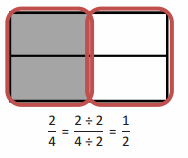
Answer:
2/4 = 1/2.
Explanation:
In the above-given question,
given that,
compose the shaded fractions into larger fractional units.
Express the equivalent fractions in a number sentence using division.
2/2 = 1.
4/2 = 2.
2/4 = 1/2.
b. 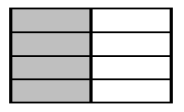
Answer:
4/8 = 1/2.
Explanation:
In the above-given question,
given that,
compose the shaded fractions into larger fractional units.
Express the equivalent fractions in a number sentence using division.
2/2 = 1.
8/4 = 2.
4/8 = 1/2.

c. 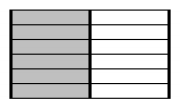
Answer:
6/12 = 1/2.
Explanation:
In the above-given question,
given that,
compose the shaded fractions into larger fractional units.
Express the equivalent fractions in a number sentence using division.
6/6 = 1.
12/6 = 2.
6/12 = 1/2.

d. 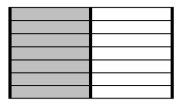
Answer:
7/14 = 1/2.
Explanation:
In the above-given question,
given that,
compose the shaded fractions into larger fractional units.
Express the equivalent fractions in a number sentence using division.
7/7 = 1.
14/7 = 2.
7/14 = 1/2.

Question 2.
Compose the shaded fractions into larger fractional units. Express the equivalent fractions in a number sentence using division.
a. 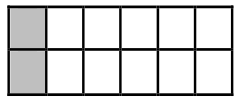
Answer:
2/12 = 1/6.
Explanation:
In the above-given question,
given that,
compose the shaded fractions into larger fractional units.
Express the equivalent fractions in a number sentence using division.
2/2 = 1.
12/2 = 6.
2/12 = 1/6.

b. 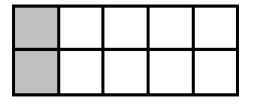
Answer:
2/10 = 1/5.
Explanation:
In the above-given question,
given that,
compose the shaded fractions into larger fractional units.
Express the equivalent fractions in a number sentence using division.
2/2 = 1.
10/2 = 5.
2/10 = 1/5.

c. 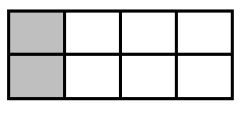
Answer:
2/8 = 1/4.
Explanation:
In the above-given question,
given that,
compose the shaded fractions into larger fractional units.
Express the equivalent fractions in a number sentence using division.
2/2 = 1.
8/2 = 4.
2/8 = 1/4.

d. 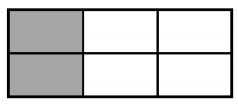
Answer:
2/6 = 1/3.
Explanation:
In the above-given question,
given that,
compose the shaded fractions into larger fractional units.
Express the equivalent fractions in a number sentence using division.
2/2 = 1.
6/2 = 3.
2/6 = 1/3.

e. What happened to the size of the fractional units when you composed the fraction?
Answer:
The size of the fractional units is increased.
Explanation:
In the above-given question,
given that,
whenever the size of the fractional units decreases when we decompose the fraction.
decomposing = dividing.
whenever the size of the fractional units increases when we compose the fraction.
composing = adding.
f. What happened to the total number of units in the whole when you composed the fraction?
Answer:
The total number of units in the whole is increased when we composed the fraction.
Explanation:
In the above-given question,
given that,
the total number of units in the whole is increased when we composed the fraction.
Question 3.
a. In the first area model, show 4 eighths. In the second area model, show 6 twelfths. Show how both fractions can be composed, or renamed, as the same unit fraction.

b. Express the equivalent fractions in a number sentence using division.
Answer:
4/8 = 1/2.
Explanation:
In the above-given question,
given that,
compose the shaded fractions into larger fractional units.
Express the equivalent fractions in a number sentence using division.
4/4 = 1.
8/4 = 2.
4/8 = 1/2.

Question 4.
a. In the first area model, show 4 eighths. In the second area model, show 8 sixteenths. Show how both fractions can be composed, or renamed, as the same unit fraction.

b. Express the equivalent fractions in a number sentence using division.
Answer:
4/8 = 1/2.
Explanation:
In the above-given question,
given that,
compose the shaded fractions into larger fractional units.
Express the equivalent fractions in a number sentence using division.
4/4 = 1.
8/4 = 2.
4/8 = 1/2.

